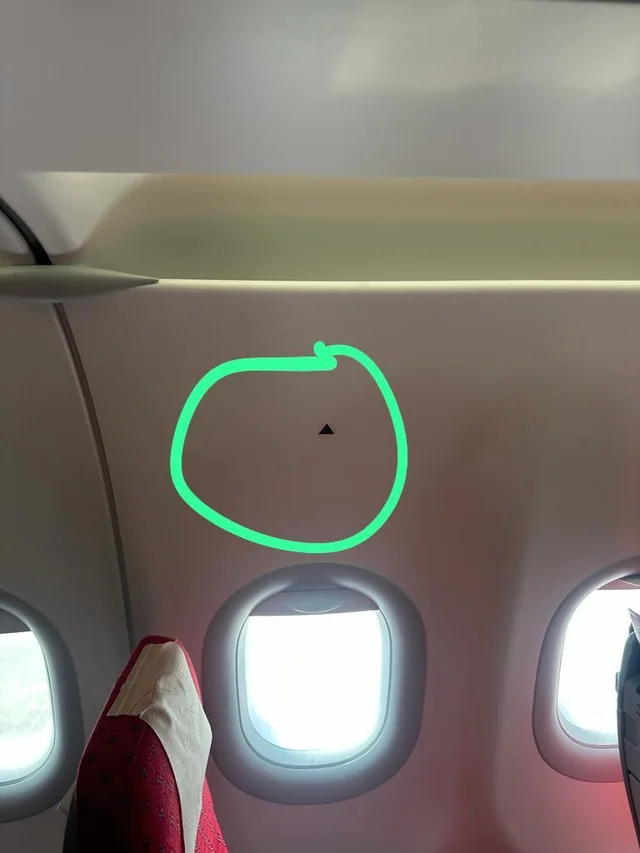Have you ever noticed the small black or red triangle stickers above the windows of an airplane? If you’re a frequent flyer, chances are you’ve seen them but never given them much thought. Surprisingly, these seemingly simple markers play a vital role in the safety and efficiency of your flight. From guiding flight crew inspections to helping with the plane’s balance, these stickers have more purpose than meets the eye. Let’s dive into what makes these small triangles so significant for air travel.

The Role of Triangle Stickers in Airplane Wing Inspections
Those triangle stickers above your airplane seat aren’t just there for decoration—they serve as key indicators for the flight crew. Aligned precisely with the edges of the airplane wings, they help pilots and flight attendants locate specific wing components quickly. Whether it’s during routine inspections or in-flight evaluations, these markers are crucial.
- Guiding the Crew: When pilots or flight attendants need to inspect the wings, these triangles act as visual guides, helping them identify the right window for the best view. This is especially important for examining moving parts like flaps and slats, which are prone to issues such as ice accumulation.
- Enhancing Safety: During flights, these markers allow crew members to efficiently check the aircraft’s wings for any signs of potential problems, contributing to overall flight safety. They eliminate the guesswork, ensuring quick access to key vantage points without unnecessary disruption to passengers.
Think of these stickers as a pilot’s compass, providing direction and clarity even during the most turbulent flights.
Why You Should Consider Sitting Near the Triangle Stickers
Did you know that your choice of seat on a plane could impact your comfort during the flight? That’s right! The triangle markers align with the wings, which are the plane’s center of gravity.
- Less Motion, Less Sickness: Imagine the airplane as a seesaw, with the wings acting as the pivot point. Sitting in this area reduces the up-and-down movement you experience during turbulence. Passengers prone to motion sickness often find these seats more stable, making for a smoother ride.
- A Smarter Seating Choice: Next time you book a flight, look for seats near these stickers—chances are, you’ll have a much calmer trip, even when turbulence hits. It’s a small detail, but one that can make a world of difference for your in-flight comfort.
So, if you often feel queasy in the air, try positioning yourself close to these markers for a more relaxed journey.
Balancing the Plane: How Triangle Stickers Aid Fuel Efficiency
It’s not just about safety and comfort; these triangles play a role in the plane’s fuel efficiency, too. On less crowded flights, flight attendants might ask passengers to move closer to the triangle-marked seats.
- Center of Gravity: Having passengers seated near the center of gravity helps distribute the plane’s weight more evenly. This positioning reduces the strain on the plane’s engines, allowing it to operate more efficiently.
- Fuel Economy: With better weight distribution, the aircraft consumes less fuel, which not only lowers costs but also reduces environmental impact. Even a slight shift in passenger seating can enhance the plane’s balance, demonstrating the importance of these markers beyond just guiding inspections.
It’s a clever way to optimize fuel usage—like placing weights evenly on a seesaw to maintain balance.
Why Pilots and Flight Attendants Rely on Triangle Stickers
Triangle stickers are essential tools for the crew, serving multiple purposes during a flight. But why are they so crucial?
- Quick Emergency Checks: In the event of an emergency or unusual turbulence, pilots might need to visually inspect the wings for damage. The triangle stickers ensure that they can do so quickly, helping to identify issues and respond appropriately.
- Routine Inspections: Even during regular flights, flight attendants may need to check the wings for ice buildup or other irregularities. The triangles provide a consistent reference point, ensuring that inspections are thorough and accurate.
These small markers pack a punch when it comes to operational safety, acting like a GPS for the crew’s eyes.

How Triangle Stickers Contribute to Overall Flight Safety
The presence of triangle stickers is more than a mere operational detail—they represent an important aspect of flight safety. Here’s how they contribute to a safer experience for everyone onboard:
- Visual Cues for Ice Accumulation: In colder climates, ice can accumulate on the wings, affecting lift and performance. The stickers make it easier for the crew to monitor these potential hazards and take corrective action if needed.
- Accurate Wing Monitoring: By aligning with specific parts of the wing, the triangles help the crew identify critical areas that require attention, ensuring that nothing is overlooked during visual checks.
These stickers might be tiny, but they play a huge role in ensuring a safer flight for passengers and crew alike.
Conclusion: Next Time, Pay Attention to Those Triangles
So, the next time you board a plane and notice the small triangle stickers above the windows, you’ll know they’re more than just random markers. They’re key indicators that aid the flight crew in inspections, contribute to passenger comfort, and even enhance fuel efficiency.
Understanding these seemingly insignificant details can deepen your appreciation for the complexities of air travel. Next time, consider choosing a seat near these triangles—not only for a smoother ride but also to observe one of the many hidden features that keep air travel safe and efficient.